在 Docker 中部署 DataKit 最佳实践
- 2025-02-28 上海
本文字数:6889 字
阅读完需:约 23 分钟

观测云 DataKit 最新推出了 Docker 安装方式,本文主要介绍如何在 Docker 中安装 DataKit。
配置和启动 DataKit 容器
登陆观测云平台,点击「集成」 -「DataKit」 - 「Docker」,然后拷贝第二步的启动命令,启动参数按实际情况配置。
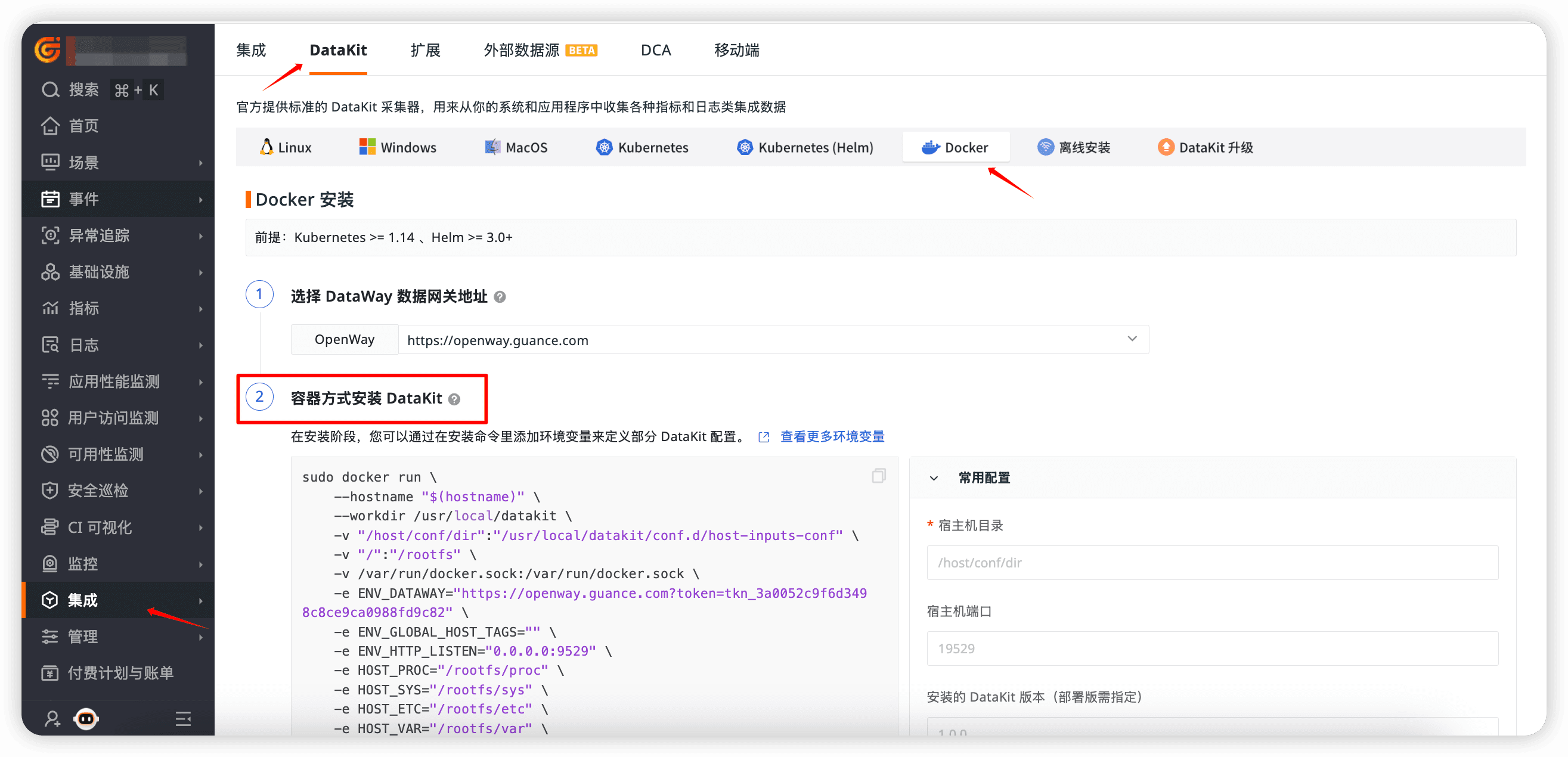
拷贝启动命令:
sudo docker run \ --hostname "$(hostname)" \ --workdir /usr/local/datakit \ -v "/etc/conf/dir/conf.d":"/usr/local/datakit/conf.d/host-inputs-conf" -v "/":"/rootfs" \ -v /var/run/docker.sock:/var/run/docker.sock \ -e ENV_DATAWAY="https://openway.guance.com?token=tkn_XXXX" \ -e ENV_DEFAULT_ENABLED_INPUTS='cpu,disk,diskio,mem,swap,system,net,host_processes,hostobject,container,dk' \ -e ENV_GLOBAL_HOST_TAGS="tag1=a1,tag2=a2" \ -e ENV_HTTP_LISTEN="0.0.0.0:9529" \ -e HOST_PROC="/rootfs/proc" \ -e HOST_SYS="/rootfs/sys" \ -e HOST_ETC="/rootfs/etc" \ -e HOST_VAR="/rootfs/var" \ -e HOST_RUN="/rootfs/run" \ -e HOST_DEV="/rootfs/dev" \ -e HOST_ROOT="/rootfs" \ --cpus 2 \ --memory 1g \ --privileged \ --publish 9529:9529 \ --name datakit-docker \ -d \ pubrepo.guance.com/datakit/datakit:1.66.2
容器启动后,查看是否启动成功:
docker ps
如下所示,启动成功:

启动参数说明:
--hostname:将宿主机的主机名作为 DataKit 运行的主机名,如果需要在当前宿主机上运行多个 DataKit,可以给它适当加一些后缀 --hostname "$(hostname)-dk1"--workdir:设置容器工作目录-v:各种宿主机文件挂载:DataKit 中有很多配置文件,我们可以将其在宿主机上准备好,通过 -v 一次性整个挂载到容器中去(容器中的路径为 conf.d/host-inputs-conf 目录)
此处将宿主机根目录挂载进 Datakit,目的是访问宿主机上的各种信息(比如 /proc 目录下的各种文件),便于默认开启的采集器采集数据
将 docker.sock 文件挂载进 Datakit 容器,便于 container 采集器采集数据。不同宿主机该文件目录可能不同,需按照实际来配置
-e:各种 Datakit 运行期的环境变量配置,这些环境变量功能跟 DaemonSet 部署 时是一样的ENV_DATAWAY: 将 token 粘贴到 ENV_DATAWAY 环境变量值中 “token=”--publish:便于外部将 Trace 等数据发送给 Datakit 容器,此处我们将 Datakit 的 HTTP 端口映射到外面的 9529 上,诸如 trace 数据设置发送地址的时候,需关注这个端口设置。--name: 指定 Docker 容器名称,否则,name 将随机生成此处对该运行的 DataKit 设置了 2C 的 CPU 和 1GiB 内存限制
假如我们在 /host/conf/dir 目录下配置了如下一些采集器:
APM:DDTrace/OpenTelemetry 等采集器
Prometheuse exporter:在当前 docker 环境中,某些应用容器暴露了自身指标(一般形如 http://ip:9100/metrics),那么我们可以将其端口暴露出来,然后编写 prom.conf 来采集这些指标
日志采集:如果某些 Docker 容器将日志写入了宿主机的某个目录,我们可以单独编写日志采集配置来采集这些文件。不过事先我们需要通过 -v 将这些宿主机的目录挂载进 Datakit 容器。另外,默认开启的 container 采集器,会自动采集所有容器的 stdout 日志
登陆观测云平台,点击「基础设施」 - 「容器」,查看名称为 datakit-docker 容器是否上报,点击进入查看容器详情。
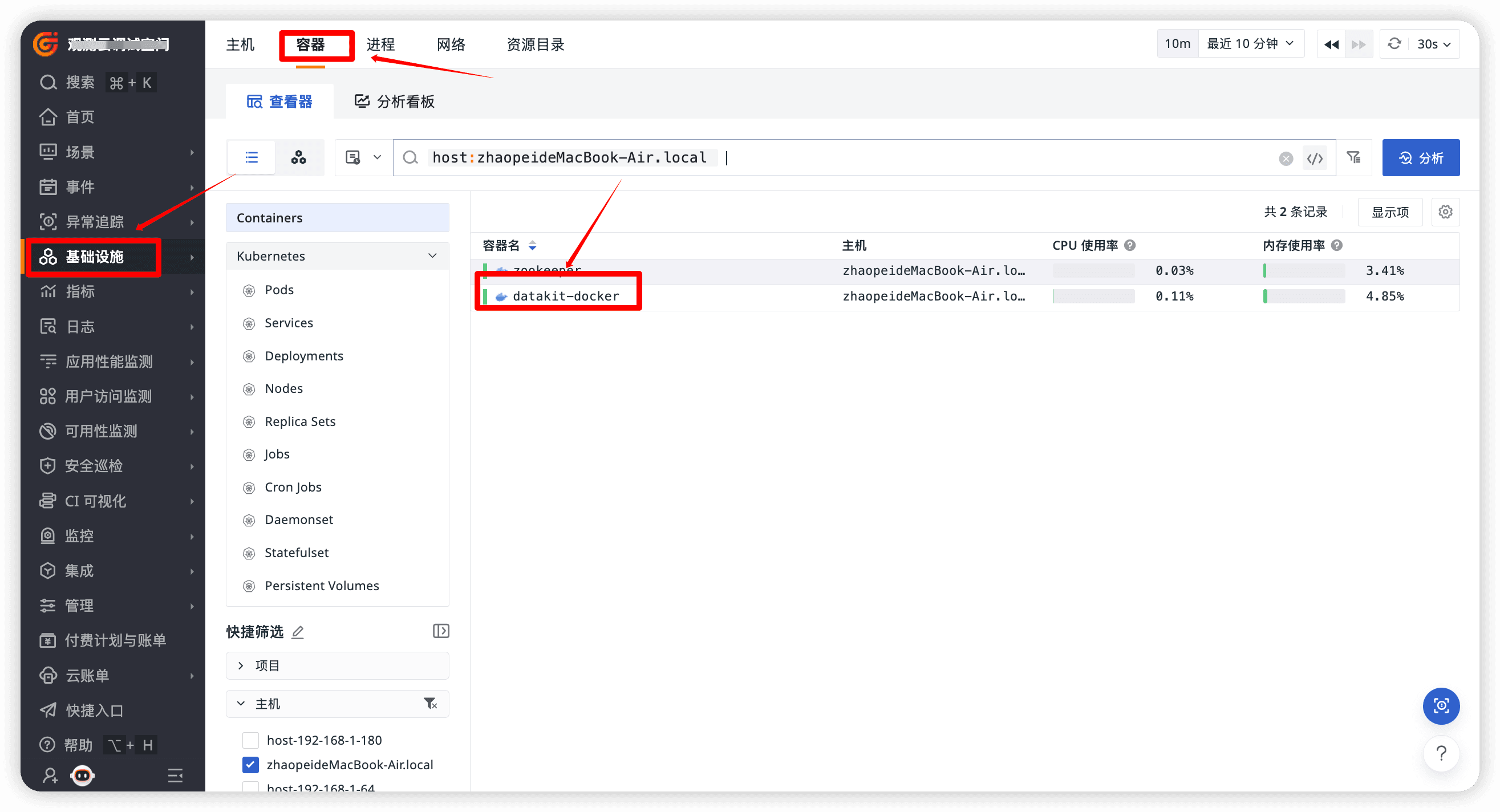

场景演示
如何使用 Docker 的 DataKit 采集用户应用访问数据。
开启 RUM 采集器
在挂载的目录 /etc/conf/dir/conf.d 下创建 rum 目录,然后在 rum 目录下,新建 rum.conf 文件,内容如下:
# {"version": "1.66.2", "desc": "do NOT edit this line"} [[inputs.rum]] ## profile Agent endpoints register by version respectively. ## Endpoints can be skipped listen by remove them from the list. ## Default value set as below. DO NOT MODIFY THESE ENDPOINTS if not necessary. endpoints = ["/v1/write/rum"] ## used to upload rum session replay. session_replay_endpoints = ["/v1/write/rum/replay"] ## specify which metrics should be captured. measurements = ["view", "resource", "action", "long_task", "error", "telemetry"] ## Android command-line-tools HOME android_cmdline_home = "/usr/local/datakit/data/rum/tools/cmdline-tools" ## proguard HOME proguard_home = "/usr/local/datakit/data/rum/tools/proguard" ## android-ndk HOME ndk_home = "/usr/local/datakit/data/rum/tools/android-ndk" ## atos or atosl bin path ## for macOS datakit use the built-in tool atos default ## for Linux there are several tools that can be used to instead of macOS atos partially, ## such as https://github.com/everettjf/atosl-rs atos_bin_path = "/usr/local/datakit/data/rum/tools/atosl" # Provide a list to resolve CDN of your static resource. # Below is the Datakit default built-in CDN list, you can uncomment that and change it to your cdn list, # it's a JSON array like: [{"domain": "CDN domain", "name": "CDN human readable name", "website": "CDN official website"},...], # domain field value can contains '*' as wildcard, for example: "kunlun*.com", # it will match "kunluna.com", "kunlunab.com" and "kunlunabc.com" but not "kunlunab.c.com". # cdn_map = ''' # [ # {"domain":"15cdn.com","name":"some-CDN-name","website":"https://www.15cdn.com"}, # {"domain":"tzcdn.cn","name":"some-CDN-name","website":"https://www.15cdn.com"} # ] # ''' ## Threads config controls how many goroutines an agent cloud start to handle HTTP request. ## buffer is the size of jobs' buffering of worker channel. ## threads is the total number fo goroutines at running time. # [inputs.rum.threads] # buffer = 100 # threads = 8 ## Storage config a local storage space in hard dirver to cache trace data. ## path is the local file path used to cache data. ## capacity is total space size(MB) used to store data. # [inputs.rum.storage] # path = "./rum_storage" # capacity = 5120 ## session_replay config is used to control Session Replay uploading behavior. ## cache_path set the disk directory where temporarily cache session replay data. ## cache_capacity_mb specify the max storage space (in MiB) that session replay cache can use. ## clear_cache_on_start set whether we should clear all previous session replay cache on restarting Datakit. ## upload_workers set the count of session replay uploading workers. ## send_timeout specify the http timeout when uploading session replay data to dataway. ## send_retry_count set the max retry count when sending every session replay request. ## filter_rules set the the filtering rules that matched session replay data will be dropped, ## all rules are of relationship OR, that is to day, the data match any one of them will be dropped. # [inputs.rum.session_replay] # cache_path = "/usr/local/datakit/cache/session_replay" # cache_capacity_mb = 20480 # clear_cache_on_start = false # upload_workers = 16 # send_timeout = "75s" # send_retry_count = 3 # filter_rules = [ # "{ service = 'xxx' or version IN [ 'v1', 'v2'] }", # "{ app_id = 'yyy' and env = 'production' }" # ]
然后重启 DataKit。
docker restart datakit-dockerdocker ps

进入容器查看是否挂载成功,如下图所示已成功挂载。
docker exec -it datakit-docker /bin/bashdatakit monitor

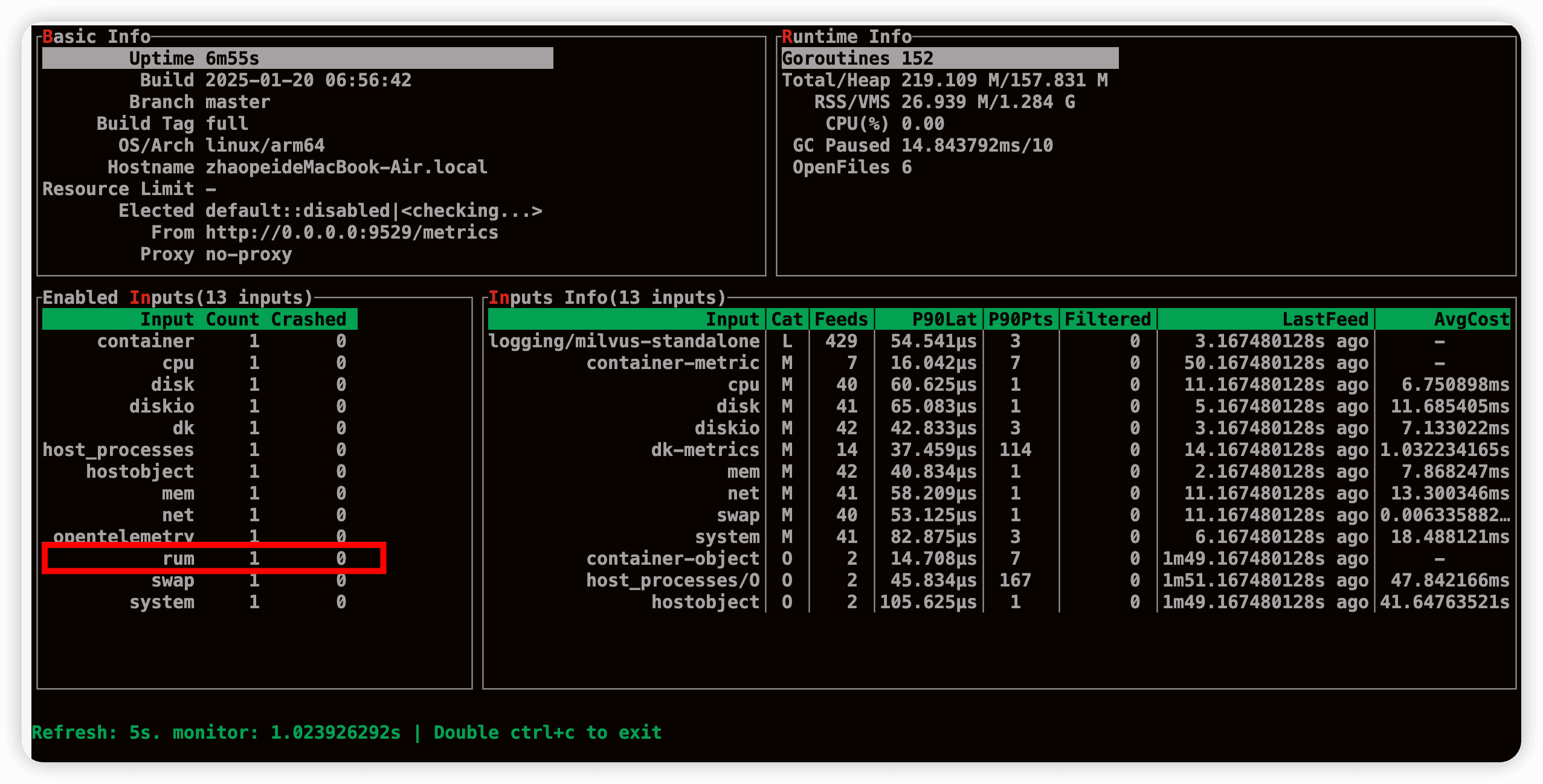
应用接入
登录观测云控制台,进入「用户访问监测」,点击左上角「新建应用」,即可开始创建一个新的应用。
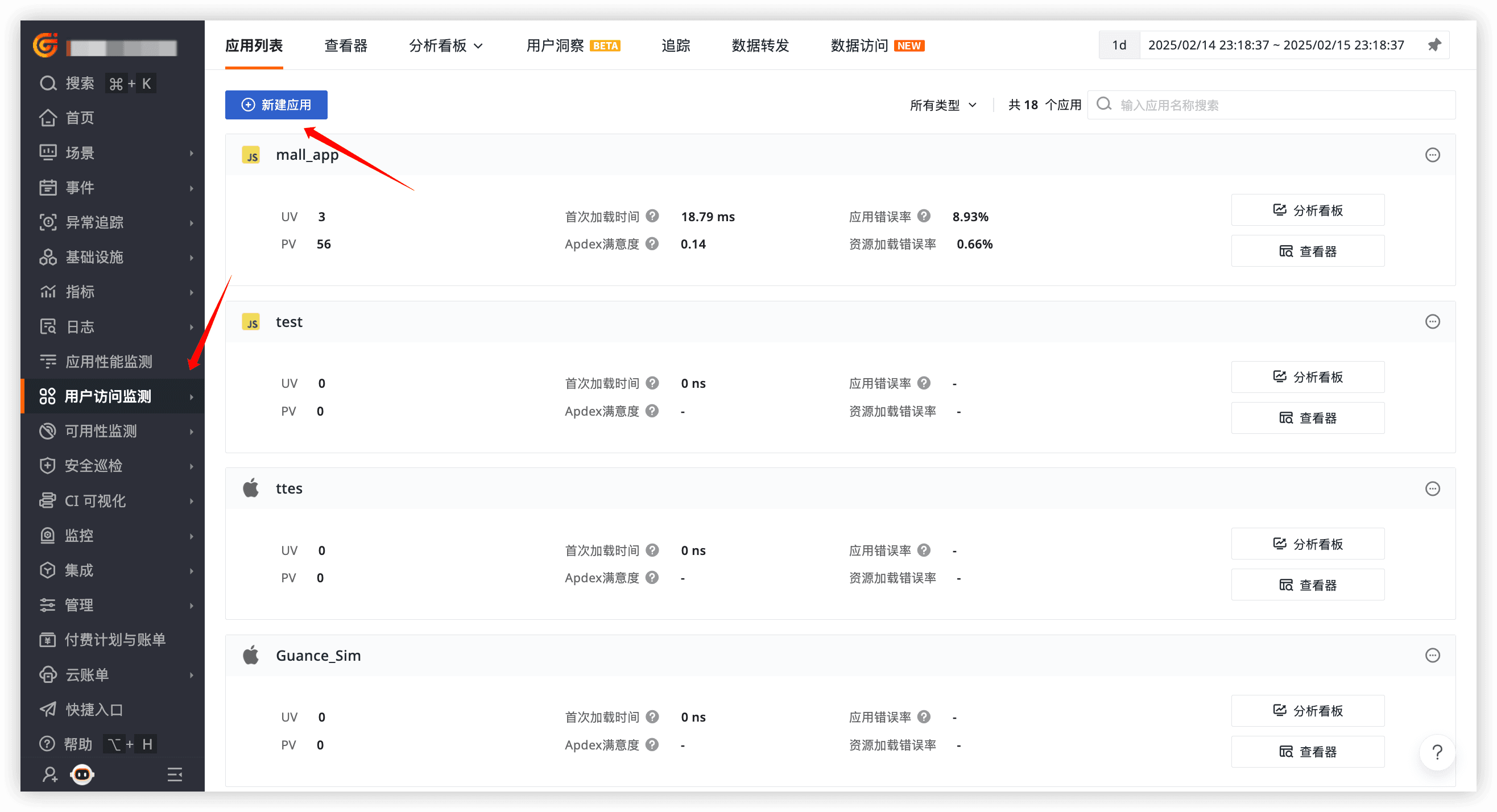
选择 Web 应用,并选择本地环境部署的 NPM 接入方式。
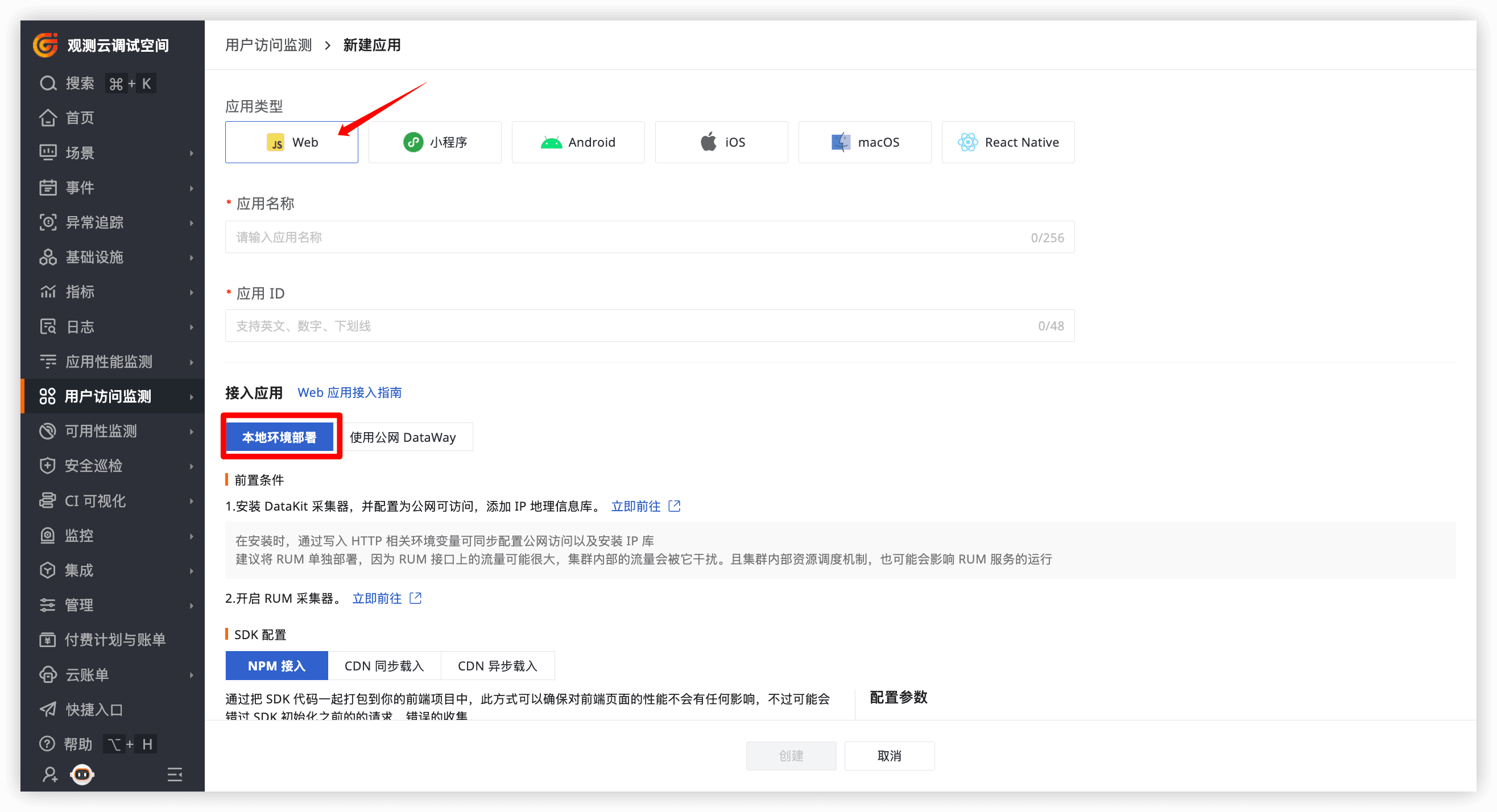
按需填入配置参数,点击创建,即可在应用列表查看应用。
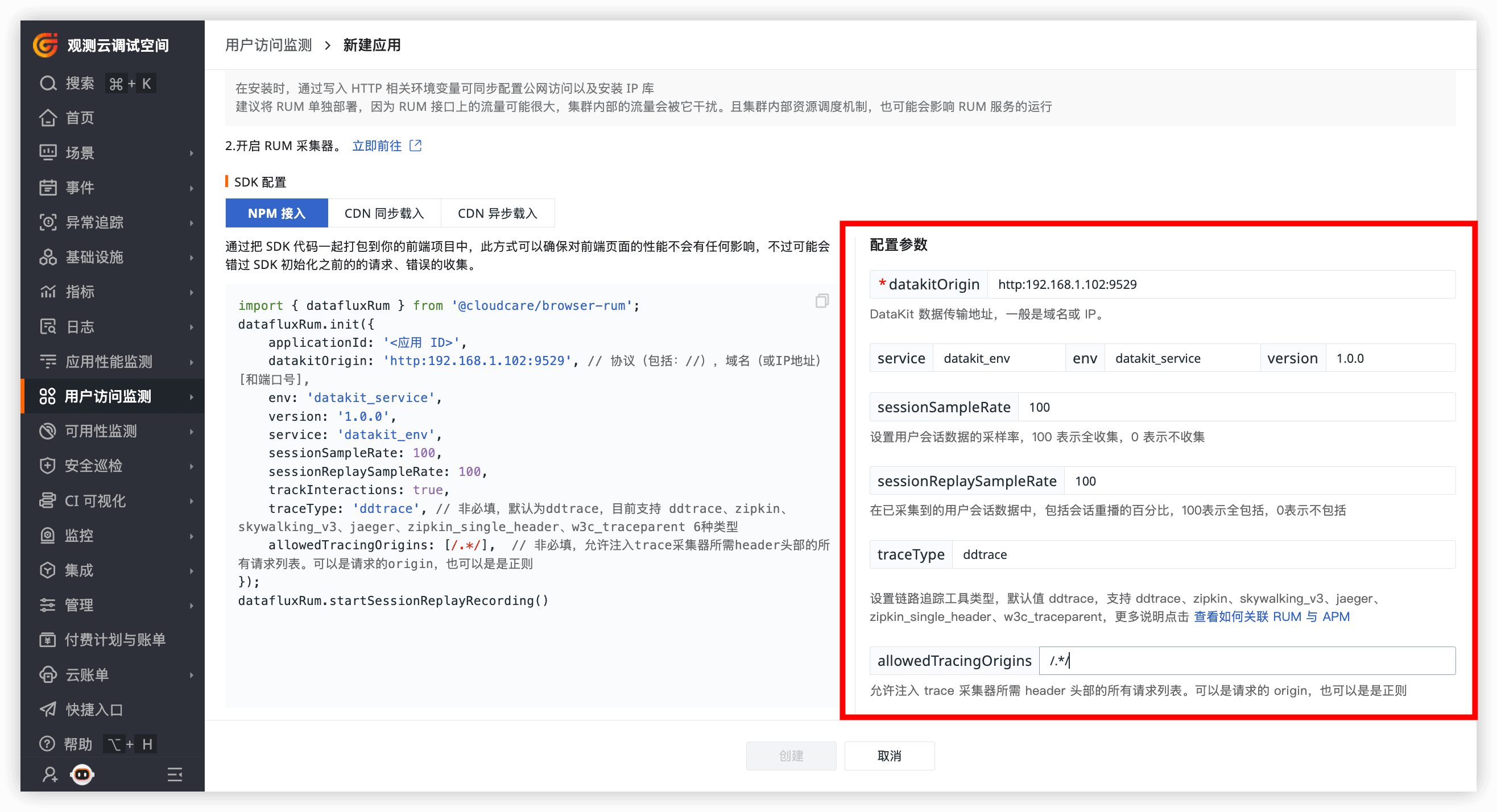
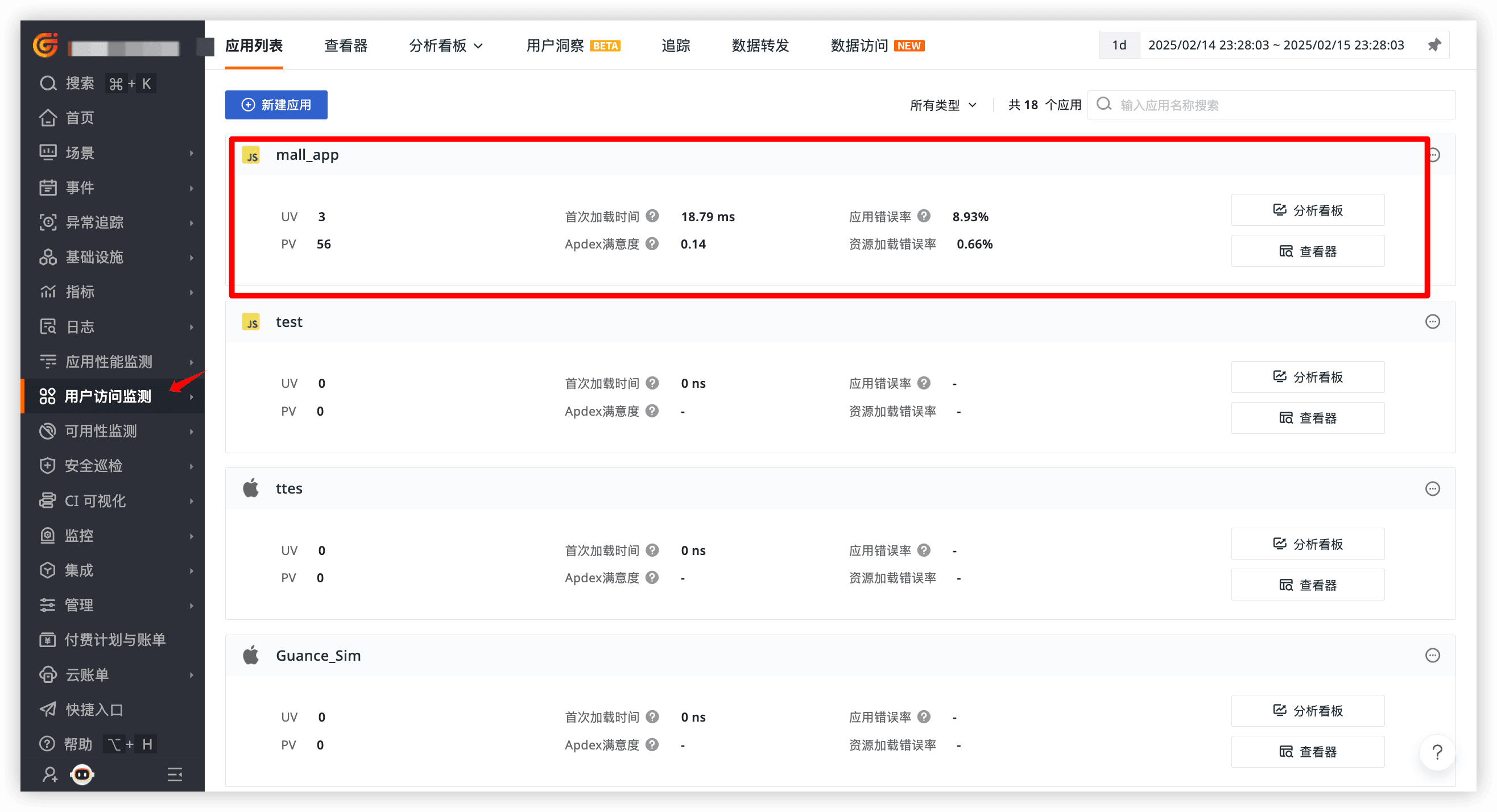
然后,将 SDK 复制到前端项目中。
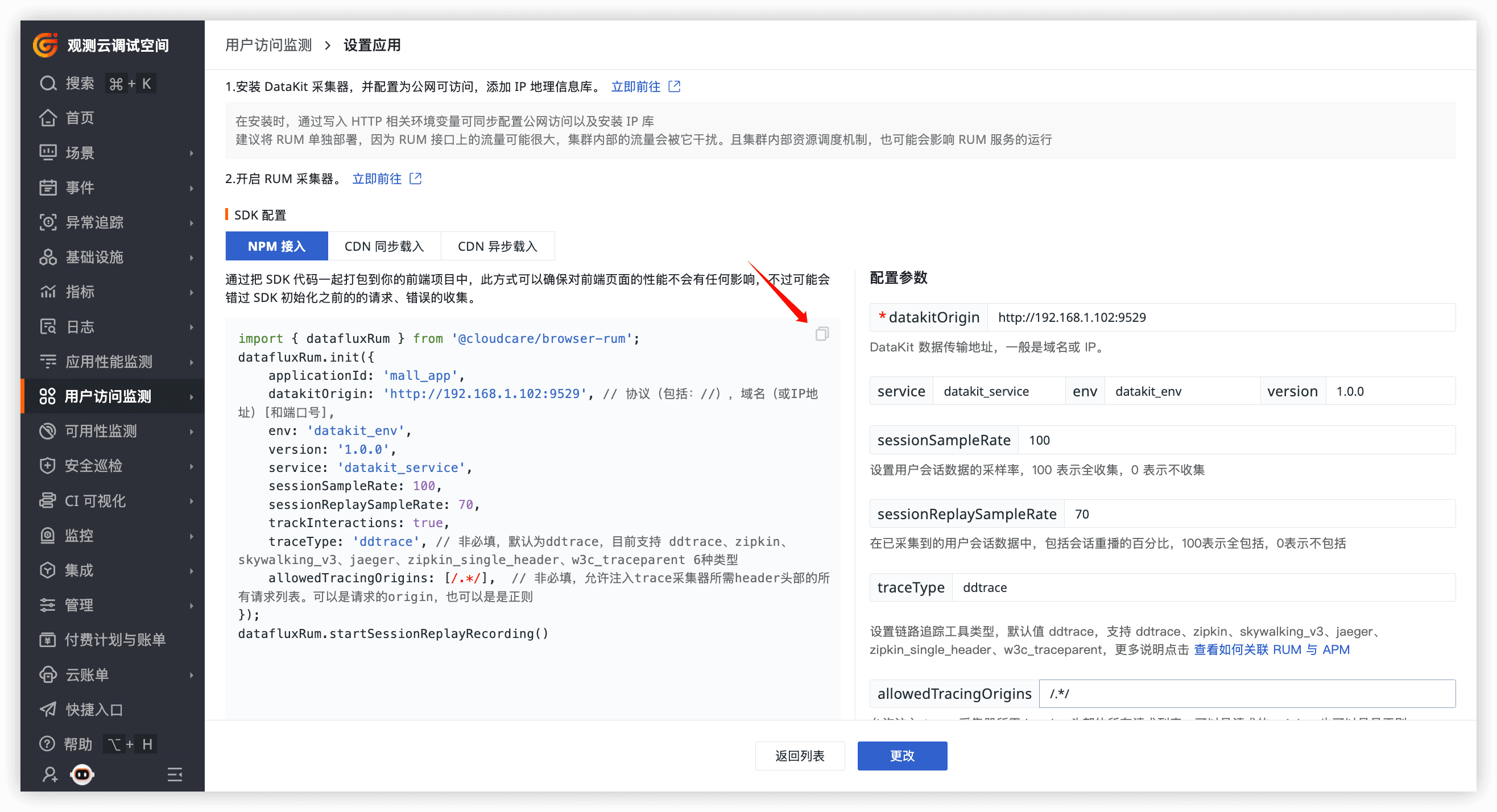
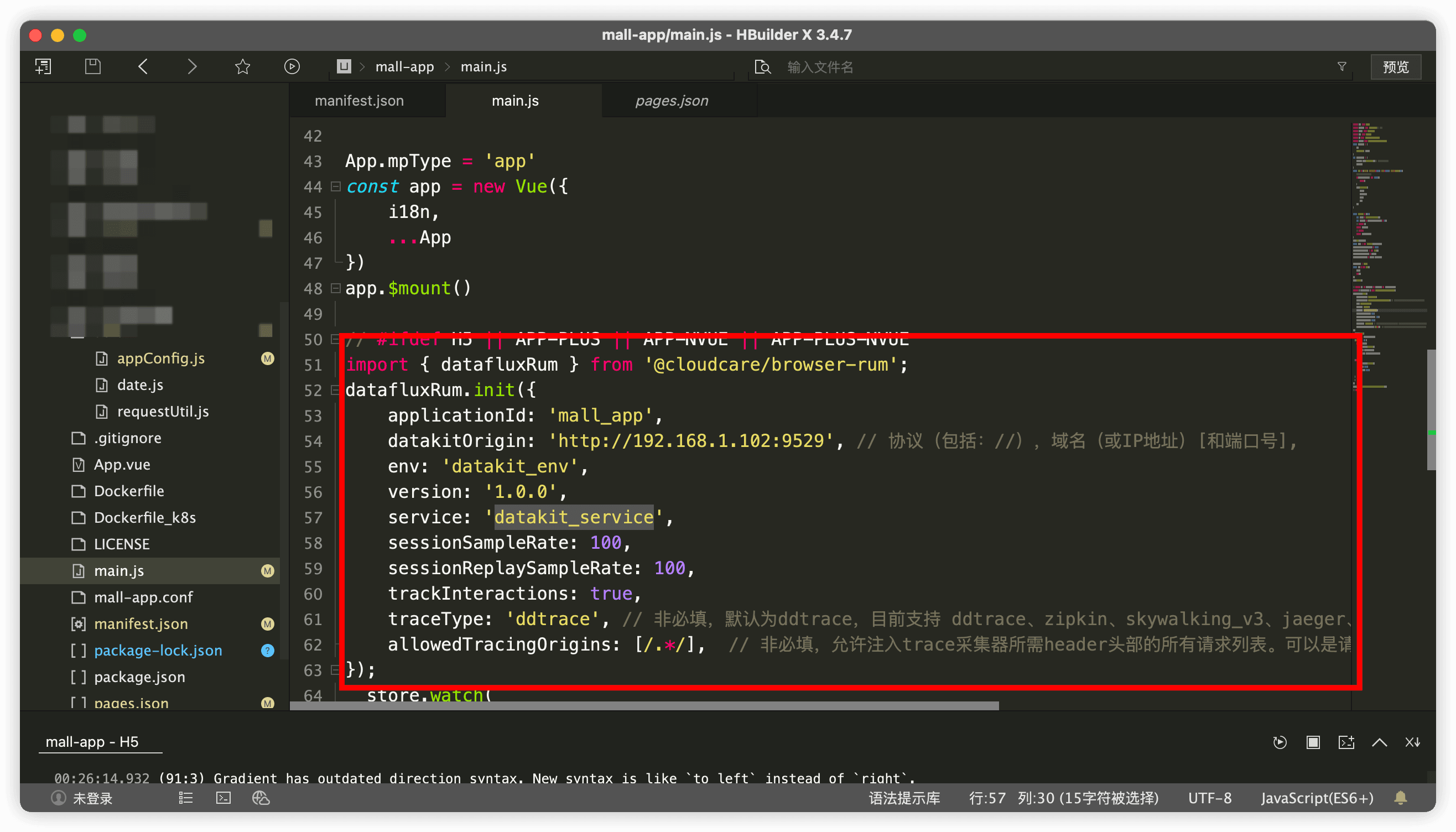
启动应用后,进行访问,相关数据会上报到观测云平台。
观测云效果
登录观测云控制台,点击「用户访问监测」 -「应用列表」,然后点击创建的应用。

点击查看器,就能查询采集到的用户访问数据。
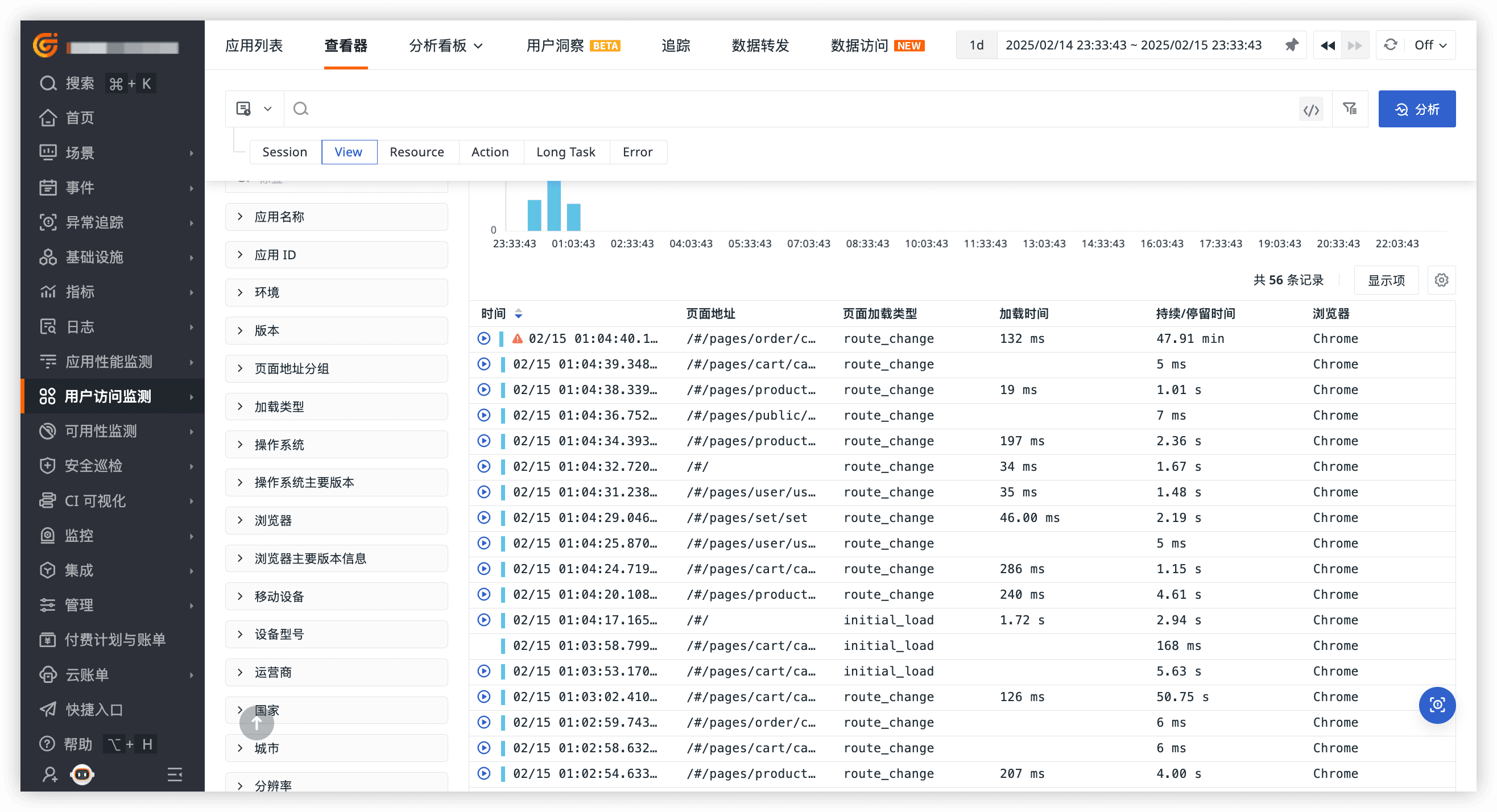
观测云
还未添加个人签名 2021-02-08 加入
云时代的系统可观测平台










评论